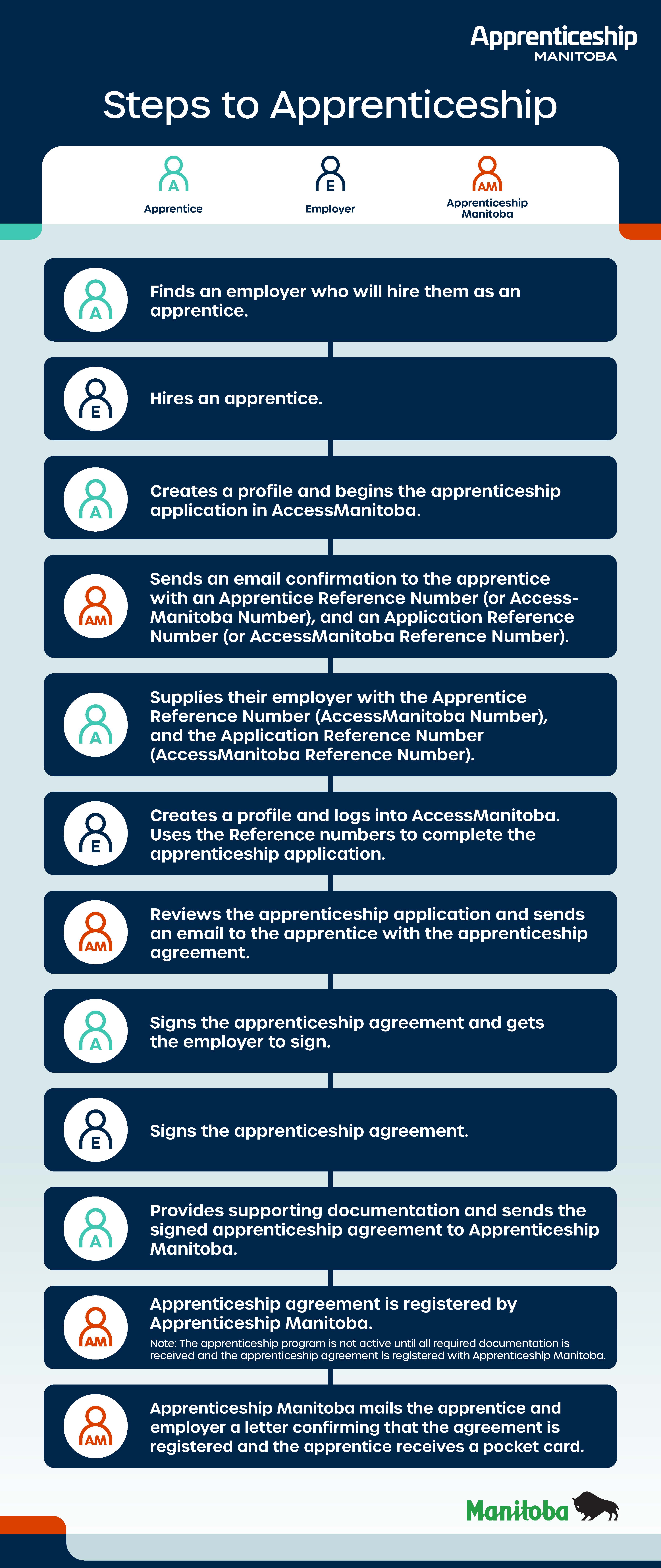Hiring Apprentices

Designated Trades
There are over 50 designated trades in Manitoba. If a trade is designated, it means that the trade is recognized through legislation and specific standards and training programs have been created for that trade.
Every trade is categorized in two ways.
-
Red Seal or Provincial:
- Some designated trades are governed by the Red Seal Program, also known as an interprovincial trade. The Red Seal is a nationally recognized program.
- Other designated trades are governed by the province of Manitoba. These programs may or may not be recognized in other provinces.
- Both Red Seal and provincial trades offer the professional designation known as a Certificate of Qualification; its holder is called a journeyperson.
- There are two pathways to achieve a Certificate of Qualification:
- Apprenticeship
- Trades qualification
-
Voluntary or Compulsory Certification:
- Voluntary designated trades means tradespeople are not required to be an apprentice or journeyperson to work in the trade.
- Compulsory certification trades means that it is illegal to work in the trade without being a registered apprentice or certified journeyperson to work in the trade. Certain trades also have additional licensing requirements.
Learn more about:
Apprentices to Journeyperson Ratio
Trade Categories – explore types of trades
Trades Profiles – explore Manitoba’s designated trades
Pathways to Certification – two pathways to certification
Labour Mobility – learn about working and training in other provinces
Apprentice Recruitment
When you hire an apprentice, you’re investing in the future of your business, your employees and Manitoba’s skilled trades. The first step is to find the apprentice that meets your business needs.
As an employer, you may have your own criteria that you look for in an apprentice and have your preferred ways that you recruit – the process to hire an apprentice is what works best for you.
Experience
Some employers value apprentices who have completed the High School Apprenticeship Program or have pre-employment training. Previous experiences like these might shorten the learning curve for your apprentice.
Learn MoreGet the Right Fit
Other employers may value fit with their team over past learning and experiences, noting that skills will be learned throughout the apprenticeship program. Meeting the candidate in person can tell you a lot about them and it’s also an opportunity to share the advantages of working with your team.
Job Fairs
Often hosted by industry, schools or community centres, a job fair or career expo is a great way to meet many potential apprentices in a short period of time.
Advertise
The Work in Manitoba job portal is an innovative, one-stop platform that connects job seekers across Canada and worldwide with Manitoba employers.
Setup your account and find your ideal apprentice or journeyperson in Manitoba today!
Many businesses post apprentice opportunities on job board sites such as:
A Diverse Workforce
Equity-deserving groups are those that have historically been denied equal access to employment, education and other opportunities. Hiring women in non-traditional trades, newcomers, Indigenous people, and people with disabilities can help you grow your workforce and enrich your team.
Some recruitment strategies to consider include:
- post job ads that state your company is an “equal opportunity employer”
- place job ads where a wide variety of people will see them, such as community training programs, community bulletin boards and fitness and recreation centres
- show people from diverse backgrounds in pictures of your company or job ads
- connect with instructors who teach pre-employment programs to get referred to potential candidates
- speak to youth in high schools and colleges about opportunities in your sector
- build ongoing relationships with trade schools and share that you’re looking for equity-deserving candidates
- encourage referrals from your existing employees
There are many services and supports in place to assist your apprentice as they work towards achieving their certification. These services and supports assist with financial needs, accessibility and accommodations, as well as well-being and mental health. Share information and resources with your apprentices and learn more about the services and supports.
Learn More Back to TopEmployer Responsibilities
When employers hire an apprentice, they must agree to fulfill certain responsibilities. Apprentices spend about 80 per cent of their time being trained on the job and about 20 per cent of their time in technical training.
Employers are expected to:
- enter into an Apprenticeship Agreement with their apprentices and have this agreement registered by Apprenticeship Manitoba
- assign a certified journeyperson or designated trainer [link] to give the apprentice supervised, on-the-job training
- ensure supervisors provide feedback to the apprentice on their performance
- ensure that the required hours of on-the-job training and technical training are completed
- report updates on the apprentice’s development and on-the-job hours using AccessManitoba
- allow the apprentice to attend required technical training and exams, see the Trades Profiles for requirements
- pay the apprentice the regulated wages
- notify Apprenticeship Manitoba if an apprentice is no longer employed by your business, this is required in writing within 15 days of the apprentice’s last day of employment
Apprenticeship Agreement
Once you’ve agreed to hire an apprentice, it’s their responsibility to begin the application process using the AccessManitoba portal. As part of the process, you and your apprentice will sign an Apprenticeship Agreement. Your apprentice’s program does not begin, and on-the-job hours are not eligible, until the Apprenticeship Agreement is registered by Apprenticeship Manitoba. So be sure to work with your apprentices to complete all information and submit the required documentation.
Here are the detailed steps showing the employer’s role in the process.
-
+ -
Step 1: Hire your apprentice
- Once you agree to hire an apprentice, make sure they understand their roles and responsibilities.
- If they do not already know how to apply, refer your apprentice to the Apply for Your Apprenticeship information for them to go through the application process.
- Your apprentice may begin working before the Apprenticeship Agreement is registered in the voluntary trades only; however, hours worked before the agreement is registered may not qualify as on-the-job hours unless listed as initial time credit on the employer page of the apprenticeship application.
-
+ -
Step 2: Log into AccessManitoba and link to your apprentice
- Once your apprentice has applied, they will receive an email with further instructions, including their Apprentice Reference Number (AccessManitoba Number), and the Application Reference Number (AccessManitoba Reference Number).
- When notified by your apprentice, you will log into your existing employer account (or create a new account).
- Navigate to Find Apprenticeship Application.
- apprentice will provide you with their Apprentice Reference Number (AccessManitoba Number), and the Application Reference Number (AccessManitoba Reference Number).
- Navigate to your portion of the apprentice application to enter the reference numbers.
- You and your apprentice are now linked in AccessManitoba.
If you need more help navigating AccessManitoba, check out the tutorial to learn more.
-
+ -
Step 3: Sign the Apprenticeship Agreement
- Apprenticeship Manitoba will send an email to your apprentice with the Apprenticeship Agreement.
- Your apprentice will provide you with either a hard copy or electronic copy that they have signed
- You sign in Part C.
Agreement Registration
Your apprentice is responsible for submitting the Apprenticeship Agreement along with any required documents. Their apprenticeship program will begin only once Apprenticeship Manitoba receives the agreement and required paperwork, and the agreement is registered by Apprenticeship Manitoba.
Work and Study Permits
If your apprentice is not a Canadian Citizen or permanent resident, a work permit and study permit will be required. If your apprentice is seeking permanent resident status, they are eligible to accumulate on-the-job hours only but cannot register nor attend technical training until permanent resident status is achieved.
Compulsory Certification Trade Requirement
Important! Apprentices are not permitted to work in a compulsory certification trade before they have received confirmation that their Apprenticeship Application has been processed and approved. Any hours that are worked prior to registration will not be counted towards the apprenticeship program. Make sure to follow up with Apprenticeship Manitoba if you have not received confirmation that your apprentice’s agreement has been processed before they begin work.
Your apprentice’s program does not begin, and on-the-job hours are not eligible, until the Apprenticeship Agreement is registered by Apprenticeship Manitoba. So be sure to work with your apprentices to complete all information and submit the required documentation.
Apprentice and Employee Steps
The following outlines all the steps you and your apprentice need to take.
 Back to Top
Back to Top


